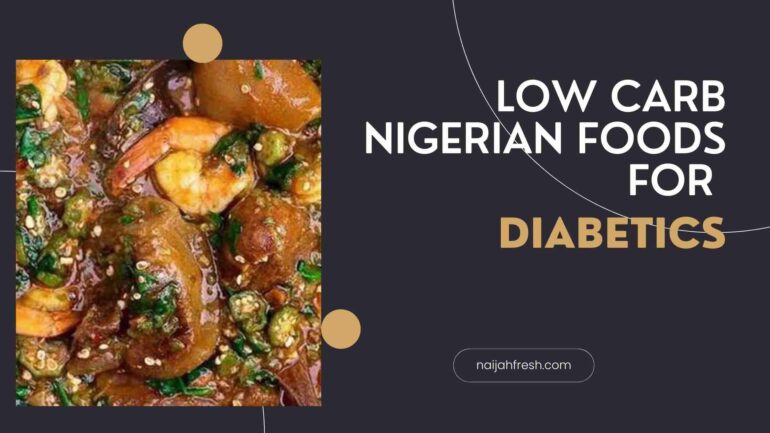Living with diabetes in Nigeria can feel like a tug-of-war between your health and your heritage.
Our food is rich, bold, and deeply rooted in culture—but what happens when the same foods we love become the ones we need to rethink?
If you’ve ever asked:
- “Can I still eat egusi if I have diabetes?”
- “Is there a way to enjoy swallow without spiking my sugar?”
- “What are the best low-carb Nigerian meals for diabetes?”
Then this guide is for you.
We’re taking a fresh, practical look at how to enjoy a Nigerian diabetic diet without sacrificing taste. Whether it’s tweaking the way you cook jollof, swapping out high-carb ingredients, or building a diabetes meal plan Nigeria style—you’ll find real answers here.
And yes—plenty of recipes, too.
Ready? Let’s get started, one plate at a time.
Why Low-Carb Matters for Diabetes (Especially in Nigeria)
When you’re living with diabetes, what you eat directly affects your blood sugar—and carbs are often the biggest culprits. But let’s pause for a second:
What exactly are carbs, and why do they matter so much?
Carbohydrates or carbs are found in common Nigerian staples like rice, yam, garri, and even beans. Once eaten, they break down into glucose, which raises your blood sugar. The more carbs in a meal, the higher and faster your blood sugar can spike.
But here’s the thing:
You don’t need to cut out carbs completely.
Instead, the goal is to choose smarter, lower-carb alternatives that give you energy—without sending your glucose through the roof.
So why go low-carb?
- Better blood sugar control: Fewer carbs = fewer spikes.
- Reduced insulin resistance: A lower-carb diet helps your body respond better to insulin.
- More balanced energy: No more sugar crashes after a big meal.
- Easier weight management: This, in turn, helps control type 2 diabetes.
In a typical Nigerian diabetic diet, small changes can make a big difference—like swapping white rice for cauliflower rice or using okra instead of garri.
You’re not giving up your food—you’re just flipping the script.
That’s the heart of building sustainable, low-carb Nigerian meals for diabetes.
Nigerian Staples to Watch (and What to Eat Instead)
Let’s be honest—Nigerian food is carb-heavy by default. Swallows, rice, yam, beans… they’re comforting, familiar, and deeply woven into our daily lives. But for someone managing diabetes, too many of these can cause your blood sugar to swing like a pendulum.
So what can you do?
Instead of cutting out your favorites completely, here’s how to swap them wisely—and still enjoy every bite.
Rice & Swallow Alternatives
| High-Carb Staple | Low-Carb Swap | Why It Works |
|---|---|---|
| White rice | Cauliflower rice | Fewer carbs, rich in fiber, lighter on the stomach |
| Pounded yam | Mashed cauliflower or plantain fufu (unripe) | Fewer carbs, still smooth and swallow-able |
| Garri (eba) | Oatmeal swallow or almond flour swallow | Low glycemic impact, more fiber |
| Semovita | Cabbage swallow or eggplant (garden egg) swallow | Great texture, very low carb |
Soups & Stews
Good news: most Nigerian soups are naturally low-carb—until we load them with starchy sides. The key is to:
- Boost the vegetables (e.g. ugu, okra, bitterleaf, spinach)
- Use lean proteins: fish, goat meat, chicken, snails
- Go easy on palm oil, crayfish, and seasoning cubes high in salt
Pro tip: Thick your soups with blended okra or garden egg instead of ground seeds or flour.
Breads & Breakfasts
| Common Option | Blood Sugar–Friendly Swap |
|---|---|
| Agege bread | Boiled eggs + avocado or coconut flour pancakes |
| Akara & bread | Akara + veggies or Akara with oat pap |
| White pap (ogi) | Oat pap or chia pudding |
Remember: the goal isn’t to demonize food—it’s to eat smarter, not less. Swapping heavy carbs for low-carb Nigerian meals for diabetes doesn’t mean giving up; it means upgrading your health, one plate at a time.
Low-Carb Nigerian Recipes You’ll Actually Enjoy
Who says healthy has to be boring?
With the right ingredients and a little creativity, you can enjoy bold, comforting, blood sugar friendly Nigerian food without feeling like you’re missing out. Below are a few easy recipes that deliver on taste and support your diabetic lifestyle.
1. Cauliflower Jollof Rice
Why it works: All the smoky, spicy flavor of classic jollof—with way fewer carbs.
You’ll need:
- 1 medium cauliflower head (grated or pulsed in a food processor)
- Fresh tomatoes, red bell peppers, scotch bonnet (blended)
- Onions, garlic, curry, thyme, bay leaf
- Tomato paste
- Seasoning cubes, salt
- Coconut or olive oil
- Optional: diced chicken, liver, or shrimp for protein
Quick tip: Stir-fry the cauliflower rice separately and mix with the sauce just before serving to avoid sogginess.
2. Unripe Plantain Fufu + Okra Soup
Why it works: Lower glycemic index than yam or cassava swallow, but still hearty.
You’ll need (fufu):
- 2–3 medium unripe plantains (peeled and steamed)
- A splash of water
- Food processor or strong blender
You’ll need (okra soup):
- Okra (chopped or grated)
- Ugu or spinach
- Crayfish, locust beans (iru), pepper mix
- Palm oil (minimal), assorted meats or fish
- Seasoning to taste
Quick tip: Blend the plantain until smooth and stretchy—reheat gently while stirring to reach “swallow” consistency.
3. Egg Muffins with Ugu and Suya Chicken
Why it works: Protein-packed, perfect for breakfast or snacking, and zero fuss.
You’ll need:
- Eggs (4–6)
- Chopped ugu (or spinach)
- Leftover grilled suya chicken, diced
- Tomatoes, onions, scotch bonnet
- Salt, black pepper, a touch of suya spice
- Muffin tray or cupcake liners
Quick tip: Bake at 180°C (350°F) for 15–20 mins until firm and golden. Store extras in the fridge.
4. Garden Egg Sauce with Boiled Eggs
Why it works: Low in carbs, rich in fiber and flavor—makes a light lunch or dinner.
You’ll need:
- 5–6 large garden eggs (boiled and peeled)
- Tomatoes, onions, pepper (blended)
- Palm oil or groundnut oil
- Crayfish, seasoning cubes
- 2–3 boiled eggs (sliced or halved)
Quick tip: Serve with a small portion of oat swallow or enjoy on its own.
Each of these meals is a win for both your taste buds and your blood sugar. These aren’t just “diabetic meals”—they’re low-carb West African recipes you’ll want to make again and again.
Want to build a full diabetes meal plan Nigeria-style? That’s what we’ll cover next.
Low-Carb Nigerian Recipes You’ll Actually Enjoy
Who says healthy has to be boring?
With the right ingredients and a little creativity, you can enjoy bold, comforting, blood sugar friendly Nigerian food without feeling like you’re missing out. Below are a few easy recipes that deliver on taste and support your diabetic lifestyle.
1. Cauliflower Jollof Rice
Why it works: All the smoky, spicy flavor of classic jollof—with way fewer carbs.
You’ll need:
- 1 medium cauliflower head (grated or pulsed in a food processor)
- Fresh tomatoes, red bell peppers, scotch bonnet (blended)
- Onions, garlic, curry, thyme, bay leaf
- Tomato paste
- Seasoning cubes, salt
- Coconut or olive oil
- Optional: diced chicken, liver, or shrimp for protein
Quick tip: Stir-fry the cauliflower rice separately and mix with the sauce just before serving to avoid sogginess.
2. Unripe Plantain Fufu + Okra Soup
Why it works: Lower glycemic index than yam or cassava swallow, but still hearty.
You’ll need (fufu):
- 2–3 medium unripe plantains (peeled and steamed)
- A splash of water
- Food processor or strong blender
You’ll need (okra soup):
- Okra (chopped or grated)
- Ugu or spinach
- Crayfish, locust beans (iru), pepper mix
- Palm oil (minimal), assorted meats or fish
- Seasoning to taste
Quick tip: Blend the plantain until smooth and stretchy—reheat gently while stirring to reach “swallow” consistency.
3. Egg Muffins with Ugu and Suya Chicken
Why it works: Protein-packed, perfect for breakfast or snacking, and zero fuss.
You’ll need:
- Eggs (4–6)
- Chopped ugu (or spinach)
- Leftover grilled suya chicken, diced
- Tomatoes, onions, scotch bonnet
- Salt, black pepper, a touch of suya spice
- Muffin tray or cupcake liners
Quick tip: Bake at 180°C (350°F) for 15–20 mins until firm and golden. Store extras in the fridge.
4. Garden Egg Sauce with Boiled Eggs
Why it works: Low in carbs, rich in fiber and flavor—makes a light lunch or dinner.
You’ll need:
- 5–6 large garden eggs (boiled and peeled)
- Tomatoes, onions, pepper (blended)
- Palm oil or groundnut oil
- Crayfish, seasoning cubes
- 2–3 boiled eggs (sliced or halved)
A quick tip: Serve with a small portion of oat swallow or enjoy on its own.
Each of these meals is a win for both your taste buds and your blood sugar. These aren’t just “diabetic meals”—they’re low-carb West African recipes you’ll want to make again and again.
Want to build a full diabetes meal plan Nigeria-style? That’s what we’ll cover next.
Sample Diabetes-Friendly Nigerian Meal Plan (Naija Style)
Here’s a simple 1-day diabetes meal plan Nigeria edition—balanced, realistic, and rooted in the local foods you know and love. You can mix and match based on what’s in your kitchen.
Breakfast
Akara with oat pap (sweetened with cinnamon or stevia, not sugar)
- 1 boiled egg for extra protein
- Warm water or unsweetened green tea
🔹 Why it works: Keeps you full with healthy fat and protein, while ditching the sugar-heavy white pap.
Lunch
Cauliflower jollof rice
🔹 Why it works: A satisfying combo with fewer carbs, more fiber, and healthy fat to slow sugar spikes.
Dinner
Unripe plantain fufu
- Okra soup with ugu and assorted meats
- Water or zobo (unsweetened)
🔹 Why it works: Low-carb swallow, nutrient-packed greens, and rich proteins = a great blood sugar-friendly combo.
Snacks (Optional)
- Handful of groundnuts or walnuts
- Garden egg with peanut butter
- Greek yogurt (unsweetened) with a few chunks of pawpaw
🔹 Why it works: Keeps you satisfied between meals and prevents cravings.
Final Words: You’ve Got This
Managing diabetes doesn’t mean your meals have to be bland, foreign, or unfamiliar. With a few tweaks, you can enjoy delicious low-carb Nigerian meals for diabetes that nourish your body, honor your culture, and keep your blood sugar steady.
So the next time you’re tempted to give up on your favorite dishes, remember—you don’t have to.
You just have to cook them smarter.
Ready to take control of your health—one plate at a time? Start by trying just one recipe from this post. Then another. Before you know it, this won’t feel like a “diabetic diet”… it’ll feel like home.



